NOTES
ABOUT THIS PUBLICATION
This publication provides detailed national accounts estimates for the years 1996-97 to 2004-05.
FEATURE ARTICLE
A feature article has been included in this issue entitled 'Updated national accounts annual benchmarks.' An abstract of the article is presented on page 10. The full article is available on the ABS web site. Directions to the location of the article are given at the end of the abstract.
REVISIONS IN THIS ISSUE
The estimates in this issue incorporate new and revised estimates from the annual supply and use tables for 1994-95 to 2003-04 and updated data from other sources which normally become available by this time each year. To ensure continuity of time series, revisions to the supply and use tables have been applied over the full length of the dataset. Please refer to the feature article which provides details on the changes.
CHANGES IN THIS ISSUE
Changes have been made to some line items in the agricultural income (table 61) to better reflect the valuation concepts used in the supply and use tables.
DATA VALUES AND ROUNDING
All values, unless otherwise indicated, are shown in Australian dollars rounded to the nearest million. Values in billions of Australian dollars used in some tables refer to thousand of millions of Australian dollars. Where figures have been rounded, discrepancies may occur between the sums of the component items and totals.
NEXT ISSUE
The next issue of this publication is to be released in November 2006.
INQUIRIES
For further information contact Patricia Mahony on Canberra (02) 6252 6711 for industry and income estimates, and Daniel Smith on Canberra (02) 6252 6713 for consumption, investment and trade estimates.
ANALYSIS OF RESULTS
GDP GROWTH IN 2004-05
The volume measure of gross domestic product increased by 2.3% in 2004-05. The 2004-05 result is weaker than the average growth of 3.7% seen over the last ten years. This reflects relatively weaker growth in private gross fixed capital formation in 2004-05 and continued strong growth in imports of goods and services.
Key volume movements in expenditure on GDP in 2004-05 were:
- growth in all components of household final consumption expenditure (up 4.3%) with the main contributions coming from expenditure on rent, recreation and culture, insurance and financial services, furnishings and household equipment, and purchase of motor vehicles
- strong growth in national non-defence general government final consumption expenditure (up 5.2%)
- high levels of private business investment with new machinery and equipment maintaining strong growth at 15.7%, new building up 5.0% and new engineering construction up 9.2%
- strong growth in public corporations capital formation at the state and local level
- growth in exports of goods and services of 2.7%, following a 1.4% rise in 2003-04. Strong growth was seen in coal and mineral ore prices while the volume of exports experienced only moderate growth.
- continued strong growth in imports of goods and services, up 12.2% in 2004-05. Major contributors to this growth were imports of fuel, machinery and industrial equipment and processed industrial supplies.
From an industry perspective, strong growth over 2004-05 was shown in:
- Cultural and recreation services up 7.7%
- Accommodation, cafes and restaurants up 4.7%
- Health and community services up 4.6%
- Communication services up 4.6%
- Retail trade up 4.2%
- Transport services and storage up 4.0%.
Manufacturing fell by 1.0%, with the main weakness in textile, clothing and footwear production and metal products manufacturing. Agriculture, forestry and fishing was also weaker, falling by 6.1% in 2004-05 following the strong rebound in agricultural production in 2003-04 of 31.3%.
GDP in current prices grew 6.4%. For the income components, there was growth in compensation of employees of 7.0%, growth in the gross operating surplus (GOS) for non-financial corporations of 9.4%, strong growth in the GOS for financial corporations of 13.6% and a flat result for gross mixed income (up 0.2%). This last result is closely connected with the fall in agricultural production. Agricultural income, a major component of total gross mixed income, fell 5.8% in 2004-05 after an increase of 52.2% in 2003-04.
PRODUCTIVITY - MARKET SECTOR
The index of market sector multifactor productivity (MFP) decreased in 2004-05 by 1.7%, reflecting a 2.2% increase in gross value added for the market sector against an increase of 4.0% in total labour and capital inputs. Hours worked increased by 3.5% in 2004-05, resulting in labour productivity growth of -1.3% in 2004-05. Capital services continued to grow in 2004-05, recording a strong growth rate of 4.5%. The increase in capital services was more than the increase in gross value added resulting in a fall of 2.2% in capital productivity in 2004-05. The capital-labour ratio increased by 0.9% in 2004-05, reflecting stronger growth in capital relative to labour.
MFP based on quality-adjusted hours worked for 2004-05 decreased by 1.8% from 2003-04, a slightly larger decrease compared with MFP based on unadjusted hours worked. This indicates that changes in labour composition (experience and educational attainment) had a positive impact on labour input over the period. The quality adjusted hours worked series and the MFP estimates based on it are experimental.
During the most recent MFP growth cycle (1998-99 to 2003-04) MFP grew annually, on average, by 1.0% - slightly lower than the long term average between 1964-65 to 2003-04 of 1.2%. The average annual MFP growth rate of 1.0% over the most recent cycle reflected an average rate of growth of 2.2% in labour productivity and -0.7% in capital productivity.
GDP PER CAPITA
For some analytical purposes it is important to allow for the impact of population growth on movements in GDP. Reflecting growth in the population, annual growth in GDP per capita has averaged 2.5% over the last ten years. In 2004-05, GDP per capita increased by 1.2%, with output slowing after a decade of strong consumption and capital expenditure.
GDP and GDP per Capita

REAL NET NATIONAL DISPOSABLE INCOME
A broader measure of changes in national economic well-being is real net national disposable income (RNNDI). It adjusts the volume measure of GDP for the terms of trade effect, real net incomes from overseas and consumption of fixed capital. The graph below provides a comparison of annual movements in GDP in volume terms and real net national disposable income. In 2004-05, RNNDI (up 3.3%) grew more strongly than GDP (up 2.3%) reflecting very strong growth in the terms of trade, offset to some extent by growth in real net incomes payable to the rest of the world.
GDP and RNNDI

WAGES SHARE OF TOTAL FACTOR INCOME AT CURRENT PRICES
The wages share remained relatively stable during the 1990s, at levels similar to those during the 1960s. The highest recorded value of the wages share of total factor income was 62.6% in 1974-75. In more recent times, the wages share has trended down since 1996-97 to 54.0% in 2004-05.
Wages Share of Total Factor Income

PROFITS SHARE OF TOTAL FACTOR INCOME AT CURRENT PRICES
The profits share (based on GOS for financial and non-financial corporations) of total factor income reached 26.2% in 2004-05 and this represents the highest share recorded since 1959-60. The profit shares recorded since the early 1990s are at a distinctly higher level than those at any time since 1959-60. This profit share measure should not be interpreted as a direct measure of 'profitability' for which it is necessary to relate profits to the level of capital assets employed.
Profits Share of Total Factor Income
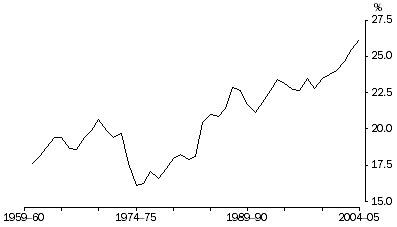
SECTORAL NET SAVING AT CURRENT PRICES
Overall, national net saving was positive in 2004-05 at $41.7 billion or 4.7% of GDP.
Household net saving as a ratio to GDP generally increased from 1959-60 to a peak in 1974-75 of 11.4%. The series then gradually decreased to its current ratio of -2.1% (a net saving level of -$18.4 billion in 2004-05). However, household net worth at 30 June 2005 was $3,825 billion, an increase of 10.5% on the position a year earlier. Further analysis of household income, consumption, saving and wealth is presented in Table 48.
Net Saving, By Sector - relative to GDP
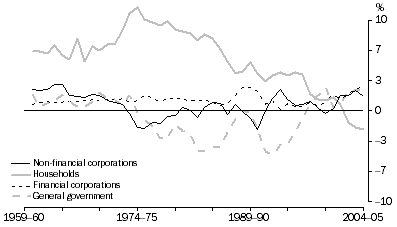
In 2004-05, financial corporations net saving was 2.8% of GDP ($24.6 billion). General government net saving represented 2.4% of GDP ($21.4 billion) and net saving for non-financial corporations represented 1.6% of GDP ($14.1 billion).
INVESTMENT AT CURRENT PRICES
As a proportion of GDP, investment (total gross fixed capital formation) by non-financial corporations generally fell during the 1970s and was reasonably stable up to the 1990s. It has subsequently been above 10% except for the years 1991-92, 1992-93 and 2001-02. In 2004-05 investment by non-financial corporations was 11.5% of GDP. Household investment as a proportion of GDP declined steadily between 1959-60 and 1973-74 but has since remained steady at around 10% of GDP. In 2004-05 the ratio to GDP was 10.8%. General government investment as a proportion of GDP peaked at 4.6% in 1975-76 and it has generally fallen since then. It was 2.2% of GDP in 2004-05. The highest ever level of financial corporations investment, expressed as a proportion of GDP, was recorded in 1989-90 (2.0%). It has generally fallen since and was 0.9% of GDP in 2004-05.
Investment, By Sector - relative to GDP
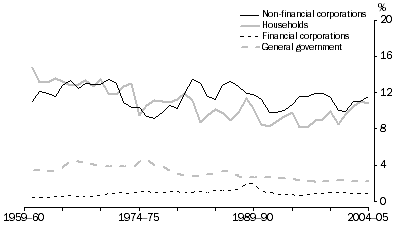
SECTORAL NET LENDING AT CURRENT PRICES
If a sector's gross saving and net capital transfers received exceed its level of investment in any period, that sector will have positive net lending to other sectors. Conversely, if a sector's investment expenditure exceeds its gross saving and net capital transfers received, then that sector will need to borrow from other sectors, i.e. its net lending will be negative.
The household sector was a lender to other sectors in the economy for all years up to 1994-95. Since then it has been a net borrower from other sectors except for 1995-96 and 1996-97. As a proportion of GDP, borrowing by households was 7.1% in 2004-05. Borrowing by non-financial corporations has fluctuated significantly over the period from 1959-60 to 2004-05 and represented 2.9% of GDP in 2004-05. General government was a net borrower for all years from 1970-71 to 1996-97. After recording a record level of borrowing as a proportion of GDP in 1992-93 (5.9%), general government borrowing declined and from 1997-98 they have became a net lender to other sectors for most years. The financial corporations sector has been a net lender for most years with net lending to GDP at 2.5% of GDP in 2004-05.
Net Lending, By Sector - relative to GDP
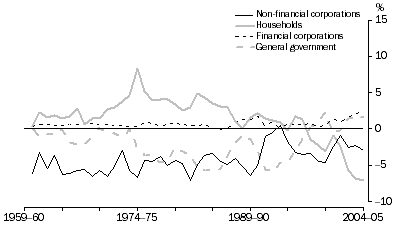
In aggregate, the four domestic sectors have been a net borrower in all years from 1959-60 except for 1972-73. The ratio of net borrowing from overseas to GDP in 2004-05 was 6.3%, the highest ratio since the start of the series.
Net Lending to Overseas, relative to GDP
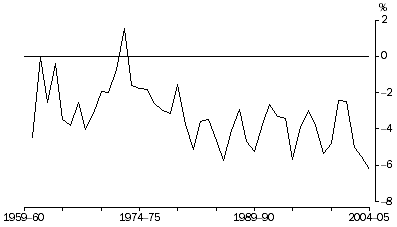
INTERNATIONAL TRADE
The growing importance of international trade to the Australian economy is illustrated by the following graph which shows the ratios of exports and imports of goods and services to GDP in current prices for the financial years 1959-60 to 2004-05. In 2004-05 the imports ratio was 21.2% and the exports ratio, which has fallen for the past four years, was 18.4%.
Exports and Imports, relative to GDP

NATIONAL BALANCE SHEET
Net worth is defined as the difference between total assets and total liabilities (including shares). Australia's net worth at the end of June 2005 was estimated to be $4,458.9 billion, an increase of $408.4 billion (10.1%) since 30 June 2004. Of the increase, $38.5 billion was due to transactions (both capital and financial), and $369.9 billion was due to revaluations and other flows (including discoveries of subsoil assets). The average annual rise in net worth over the period 30 June 1992 to 30 June 2005 was 7.6%. The graph below shows that the net worth series has exhibited the strongest growth in the years since 1996-97 during which annual rates of at least 6.8% have been achieved.
Percentage change in total net worth - as at 30 June
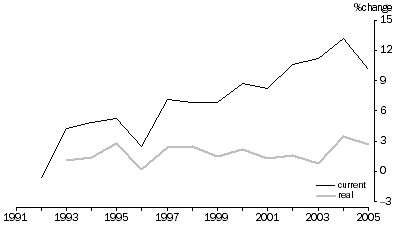
Total produced assets at 30 June 2005 were estimated at $2,695.9 billion, an increase of 8.9% from the level at the end of June 2004. The estimated value of produced assets rose at an average annual rate of 5.5% between 30 June 1992 and 30 June 2005 and consistently accounted for over 60% of net worth. At 30 June 2005, dwellings, non-dwelling construction, and machinery and equipment represented 94% of total produced assets.
The value of non-produced assets at 30 June 2005 was estimated at $2,280.0 billion, a rise of 11.5% from the level at the end of June 2004. The average annual rise between 30 June 1992 and 30 June 2005 was 11.1%. Over this period, the share of land fell from around 90% to 85% of total non-produced assets.
The difference between Australia's assets and liabilities with the rest of the world represents the net international investment position. Australia's net liabilities stood at $516.9 billion at 30 June 2005, a rise of 9.9% on the position at the end of June 2004. Net liabilities as a proportion of net worth increased steadily from 12.0% at 30 June 1992 to a peak of 13.6% at 30 June 1996. At 30 June 2005 the proportion was 11.6%.
Australia's real net worth increased by 2.7% over the year ended 30 June 2005 compared with the average annual growth over the period 30 June 1992 to 30 June 2005 of 1.9%. In the latest year the real value of non-financial assets grew by 3.3%, the real value of financial assets fell by 2.3% and the real value of liabilities grew by 2.0%.
 Print Page
Print Page
 Print All
Print All